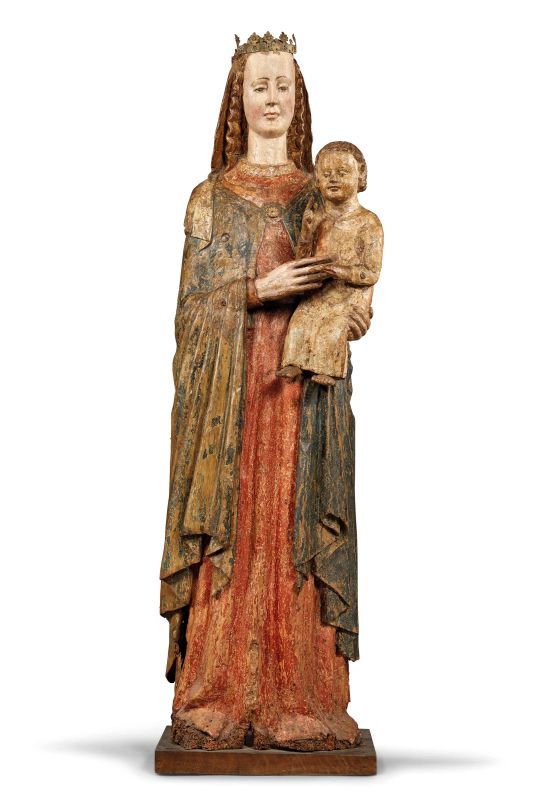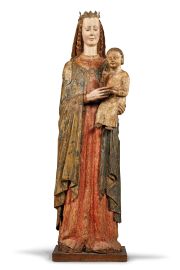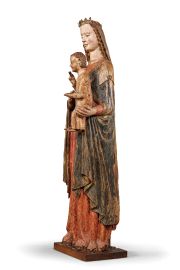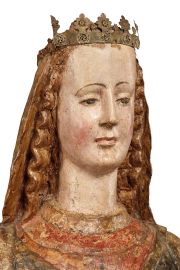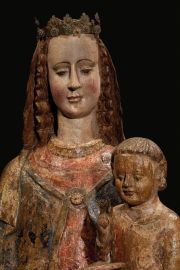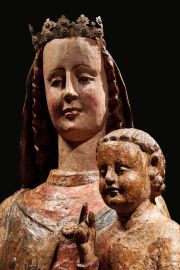Maestro della Madonna di Riomaggiore (Master of the Madonna of Riomaggiore)
Maestro della Madonna di Riomaggiore (Master of the Madonna of Riomaggiore)
(sculptor of the Campione school active in Liguria in the early 14th century: “Maestro di Giano” ?)
MADONNA AND BLESSING CHILD
polychrome wooden statue, 165x56x38 cm
An export licence is available for this lot
Bibliography
J. Boccador - E. Bresset, Statuaire médiévale de collection, s.l. 1972, p. 56 fig. 50
This regal, sophisticated statue presents the iconography of the “Madonna in Majesty” which usually depicts the Virgin enthroned with the Infant Jesus seated on her left arm and raising His hand in blessing. This iconography was very popular in wooden sculpture between the second half of the thirteenth century and the early decades of the fourteenth in a more unusual rendering with the Virgin standing erect, making the figure more powerful and impressive. The solemn, stately tone, emphasized by the immobile frontal position of the Christ Child, with the features of a little emperor sheathed in His simple tunic, is softened by the noble grace of Mary’s face and her gentle hand on her son’s stomach. These features speak to the transition from the more abstract, iconic shapes of the Romanesque tradition towards the naturalism and sorrowful humanity of Gothic art. The statue, which is noteworthy for the conservation condition of the carving and polychromy (even the gilded copper coronet that is finely decorated with relief stars and openwork seems pertinent), is important evidence of the development of wood sculpture in Liguria. It can be dated to the early decades of the fourteenth century and a very interesting cultural climate.
The stiff frontal arrangement and the almost cone-shaped structure of the group, the Child’s rigid posture, the faces - His round and Mary’s slender; the hair – hers dressed in waves, and the Child’s ancient-style; the verticality of the folds of the robe and mantle that opens like a fan in zigzagging, sharp folds show that this piece is very closely related to the wooden Madonna of the Chains in the oratory of Nostra Signora Assunta in Cielo at Riomaggiore, described by Piero Donati (in La Sacra Selva. Scultura lignea in Liguria tra XII e XVI secolo, Genoa exhibition catalogue, ed. by F. Boggero and P. Donati, Geneva-Milan 2004, pp. 116-117 n. 5) with a dating around 1310. And he linked it to the work of the “maestri campionesi” – masters from Campione - the Lombard stonecutters who, at the beginning of the fourteenth century, monopolized the main construction sites in Genoa such as the Cathedral of San Lorenzo and the church of San Francesco di Castelletto.
The striking comparison made by Donati can be matched with the works of most outstanding and recognizable of these sculptors, whom scholars call the “Maestro di Giano” for the bust of Re Giano (King Janus), the mythical founder of Genoa, on a pilaster of the left-side women’s gallery of the cathedral, completed in 1307, where the same anonymous master also carved a capital depicting the Madonna and Child with Two Prophets (C. Di Fabio, La Cattedrale di Genova nel Medioevo. Secoli VI-XIV, Cinisello Balsamo 1998, pp. 280-289; R.P. Novello, “La ricostruzione dopo l’incendio del 1297”, in La Cattedrale di San Lorenzo a Genova, ed. by A.R. Calderoni Masetti and G. Wolf, Modena 2012, pp. 75-82, p. 364 n. 555, p. 367 n. 561). The marble sculptures attributed to the “Maestro di Giano” reveal a marked stylistic affinity with the wooden statues discussed here, especially all the features we have noted, and Donati’s hypothesis, albeit not shared by Novello (ibid., p. 82, note 22) maintaining that the Riomaggiore Madonna is “perhaps more than fifty years older”, has been “fully confirmed” in a recent and precise study by Federica Siddi (Scultura in legno nella Lombardia dei Visconti, doctoral dissertation, University of Trento, 2015-2016, pp. 644-646 n. XIII.4), and through comparisons with other early fourteenth-century Lombard wooden Madonnas.
This important workshop’s wooden output, which Donati “augmented” (“Verso Levante. Sculture erratiche di provenienza genovese nella Liguria orientale”, in Prospettiva, 125, 2007, pp. 22-34, p. 34 note 31; “La ‘Madonna delle Catene’ di Riomaggiore e la sua gemella di Montebruno”, in Città della Spezia, 26 April 2015) comparing the Riomaggiore statue to a standing Madonna and Child in the church of Santa Maria Assunta at Montebruno (see also Siddi, op. cit., pp. 641-642 n.XIII.3), and then by Gentilini and Lucidi who attributed a seated Madonna from the same private collection as the statue presented here to it (Pandolfini Casa d’Aste, Mobili, dipinti e sculture: ricerca e passione in una collezione fiorentina, sale catalogue, Florence, 16 October 2019, p. 169 n. 118). The Madonna presented here is the most significant evidence of their work and it is truly worth of the Maestro di Giano and his place in Genoese Gothic sculpture.
Giancarlo Gentilini and David Lucidi

